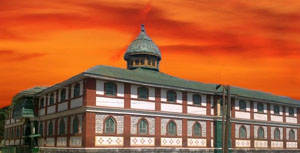
Imambara Hassanabad is the 2nd oldest shrine and is a world famous place of mourning and worship of one million shia population of J&K is Imambara Hassanabad situated in south west of city centre Lal Chowk. The Imam Bargah is surrounded by world famous Hazratbal shrine one side, Temple of Mata Sharka Devi and Gurdawara Chatti Padshahi on other side. Hassanabad was a developed city during the Moughal Rule period and the Imam Bara is surrounded by Moughal Graveyard "Baba Mazar" which is the resting place of a number of Kashmir Lumaneries i.e Baba Ali, Syed Mirza Shah , the great persian poet of 17th century "Mulah Abdul Gani" and famous poet of Kashmiri Marsia "Hab Saheb Mullah".
Budgam Imam BaraKnown as one of the prime religious attractions of Jammu & Kashmir ImamBara Budgam is located in the Budgam district of the state. A shrine meant for the Shia sect of Muslim community, ImamBara Budgam stands as a symbol of immense respect and faith in the valley.
Boasting of a magnificent architectural acumen, ImamBara Budgam comprises of five entry points one of which is specially made for the women followers. Built in 1857, ImamBara Budgam can be seen in the shape of an octagon. Influence of the Indo-Iranian construction skill is quite evident in the interior premises of ImamBara Budgam.
The Shiiete Muslim communities of the state of Jammu & Kashmir consider ImamBara Budgam as an important religious place. The followers are frequently found in ImamBara Budgam who gather there to pay their homage and seek blessings of the Almighty. During the local festivals of Muslim groups in Kashmir, ImamBara Budgam is visited by large number of people who come to offer their prayers to the feet of the ultimate divine power.
The diversity of places under the Jammu & Kashmir pilgrim tourism is quite enthralling. ImamBara Budgam is one such enticing pilgrim spot of the state which claims reverence not only from the followers of Islamic faith but also from all those who believe in other religions. As an ancient pilgrim spot of Jammu & Kashmir ImamBara Budgam has become a subject of prime interest for historians too.
The governing body of Budgam district takes every initiative time and gain that can enhance the footfalls in the shrine of ImamBara Budgam.
Zadibal Imam Bara.
Mir Shams-ud-Araqi a muslim preacher of Shia faith came from araq/Talsh (Iran) to Kashmir in the reign of Sultan Hassan Shah grand son of Budshah in 1472 AD as an ambassador of the ruler of Khurassan. Some report that he was actually exilled by the ruler/governor of Khurasan and was forced to seek asylum in the valley Kashmir. Being a renowned scholar of Shia faith having enough persuasive compatibilities as a preacher, he was able to persuade a famous noble of Chack rulling dynasty of the Srinagar (Khwaja Hussain Chak) to Shia faith, Consequently hundreds of the people who were under the influence of the noble accepted the new creed of Islam as well. In the first spell, he stayed in srinagar for eight years and preached secretly the Shiaism in the city. He went back to Iran but returned at the behest of Shia Qasim Noor Baksh, head of the Noor Bakshi sect. A first prayer house was built by Baba Ali Najar of Hassanabad, an influential Shia convert, at Zadibal for him, which was subsequently also called as Noor Bakshi Khanqah. It is during Check rule that Shiaism recieved official support in Kashmir and Shams-ud-Din (1484-1526) AD. During the period of Mirza Haidar Douglat, Shia and Sunni riots were very common in the city, which lead to huge loss of propertyand human lives. The situation went so bad that even his son Mir Daniyal and Mirza Haidar Douglat were slain in the communal frenzy. Mir Shams-ud-Din came back to srinagar and died in 1526 AD ans was buried at Zadibal Khanqah. His son Daniyal was also reburied at Zadibal Khanqah whis his dead body was retrieved from the graveyard at Dab (Ganderbal). His mausoleum is held in great esteem by Shia Muslims of Kashmir. Some of the persons have reported that Sham-ud-Din's dead body was removed stealthily from the graveyard at Zadibal and taken to Chadora for re-burial by his commited followers, in order to avoid any disrespect or damage to the dead body during acute sectrian riots. The grave has been now identified at Chadora, restored and repaired by Aga Sahib of Budgam and is visited by large number of Shia Pilgrims.